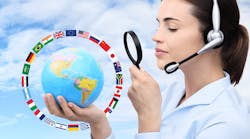Latest from Professional Development/Leadership
HUMAN NETWORK: Legal Risks in Translations
Hanging On Every (Foreign) Word
Janel and her business partner Kevin go all in on their wearable tech startup. They even get foreign patents translated into English to make sure there are no conflicts with their idea.
Three years later, when their products are finally hitting the shelves, they receive a cease and desist letter. One of the Japanese patents that they had translated is now in force in the US with significantly different wording than their translation.
In the US version of the patent, the term that their translator had rendered as “foot” is translated as “lower limb.” This would cover Janel and Kevin’s device, which senses movement in the knees. It seems minor, but the difference in wording could render their own patent application invalid, and possibly put their business on the hook for infringement. Their attorney runs the matter by 2 different experts, but the facts are clear: while in casual conversation, the Japanese term can often refer to just the foot; according to any dictionary, it can also refer to the entire limb.
So, the Japanese patent covers their device — and years of work go down the drain.
Janel and Kevin learn a hard business lesson of the globalized world: in matters of law, every word counts, even when written in another language.
Similar risks arise when translating agreements, contracts, specifications, annual reports, bills of sale, and even some letters. In questions of evidence, such as for patents, it is the original document that counts, and inaccurate translations can be contested in court. In other situations, the translation itself can be paramount — even when it is wrong. If you are using a French court to enforce a contract signed in French, it doesn’t much matter what the original English version said.
To avoid translation problems, it is useful to understand how they happen. In every language, individual words can have multiple meanings. Think about the possible meanings for “sentence,” or “right,” or even “impregnate.”
Meanwhile, words don’t map one-to-one into other languages. For example, the Chinese word for “sentence,” meaning a grammatical unit, is totally different from the Chinese word for “sentence,” meaning a punishment. To pick the right one, a translator must first understand the exact meaning of the words in the original context.
Now think about how well the average person understands each and every word in a contract, let alone in a patent!
Which brings us to Rule #1: Use a specialist.
You wouldn’t go to your dermatologist to set your broken leg, and you shouldn’t have your legal or scientific translations done by the translator who localized your website. Find a translator or translation agency that specializes in the type of document that you need translated.
The next problem is caused by being human. When Gutenberg invented the printing press, the first and biggest impact was the elimination of transcription errors that, before the year 1439, had made each version of hand-copied manuscripts a little different.
In the same vein, if you’ve ever played the children’s game “telephone,” you will have seen how easily humans make errors when they try to reproduce phrases faithfully. Now think about doing it between 2 languages!
Because people also have trouble spotting their own errors, the best practice is to have one or even 2 additional translators review the first translator’s work.
And so we have Rule #2: Use a team.
Translation agencies have different quality assurance processes — from no-review, to spot-checking, to three-person verification. If the document could have important legal consequences, talk to your provider about their process. For critical translations, it may even pay to hire your own independent reviewer.
If you are starting to wonder how much all this costs, you’re asking a good question. What Janel and Kevin really needed for their patent translation was a person, who was not only fluent in Japanese and English, but who would also understands the circuit technology involved in wearable devices, and knows patent law well enough to grasp that the broadest interpretation of the terms would be required in the translation. They also needed 1 or 2 more similarly qualified people to check the translation, and someone to coordinate all those things.
Hence, Rule #3: Beware of “bargains.”
If mistakes could hurt your business, don’t go with the place that offers to cut costs without first making sure that they won’t cut quality.
If you will be submitting the translation to a court or government agency, you may need to have it certified.
But even in cases where a certification is not required by law, requesting one puts the translation provider on notice — right from the start — that you need a true and faithful translation for legal purposes, rather than the looser, more broadly interpretive renderings that are prepared for simple information.
Let’s add Rule #4: Get it certified.
A certification is a statement of the translator’s good faith belief that the translation is true to the original, not a guarantee of accuracy, so don’t forget Rules 1, 2, and 3.
Of course, not every translation requires this level of expertise. Even a machine translation may be enough to tell you whether a foreign patent has any connection to your invention. Likewise, a bilingual administrative assistant might be able to prepare a first-draft translation of an agreement when you are still in the negotiating stage.
But before you pick up your pen to sign a contract, or commit to spending the next few years working on a new product, make sure that the final translation is reliable. Be sure it was prepared by a specialist, who was backed up by a team. Make certain you have good reason to be confident in the quality. And see that the translation has been certified.
These simple steps can make all the difference when your success depends on every foreign word.
About the author: Martin Cross is the president of Patent Translations Inc., serving law firms and patent departments in the US and abroad, and an active corporate member of the American Translators Association. The American Translators Association represents over 10,000 translators and interpreters across 91 countries. Along with advancing the translation and interpreting professions, ATA promotes the education and development of language services providers and consumers alike. For more information on ATA or translation and interpreting professionals, please visit www.atanet.org.




